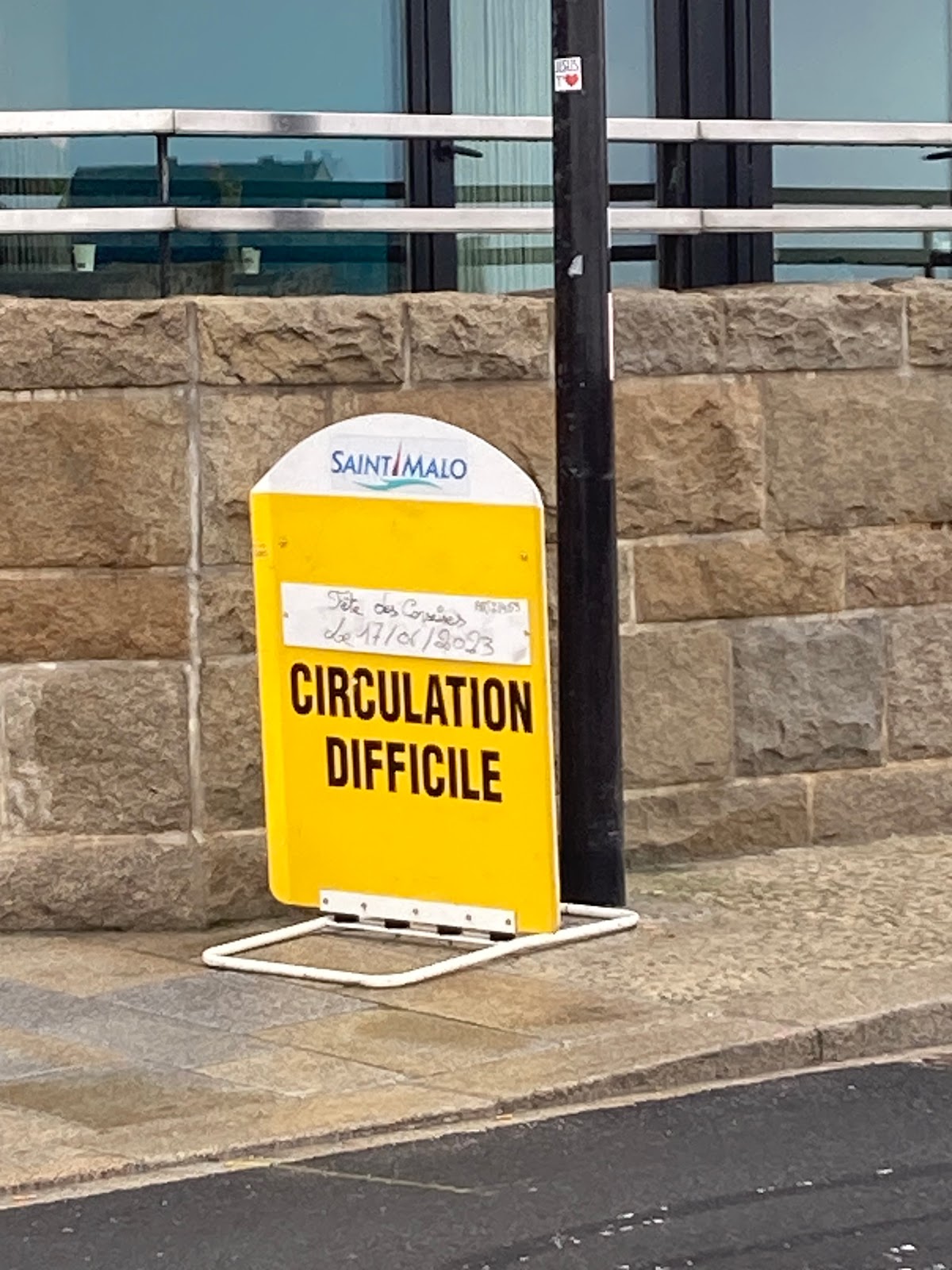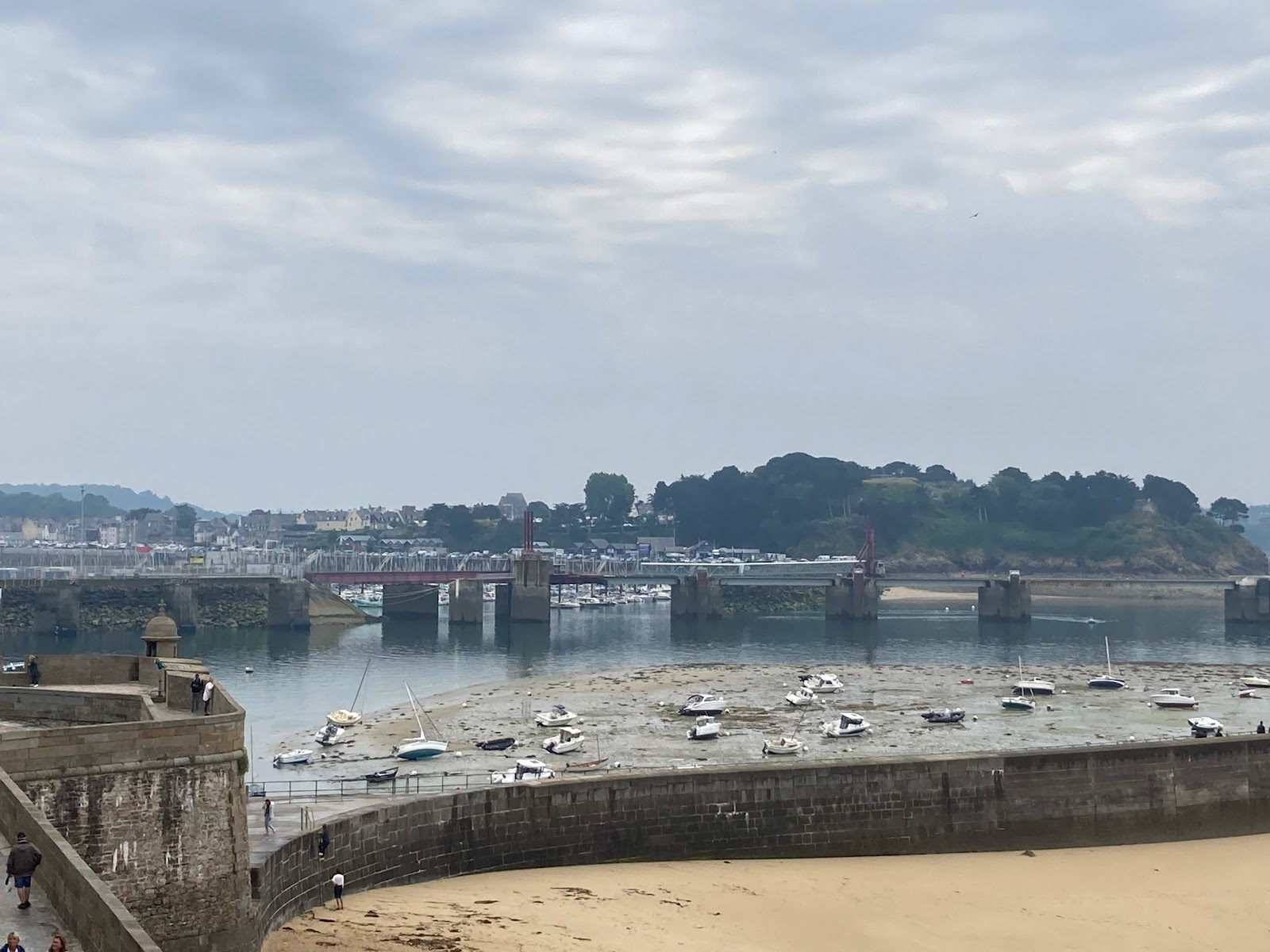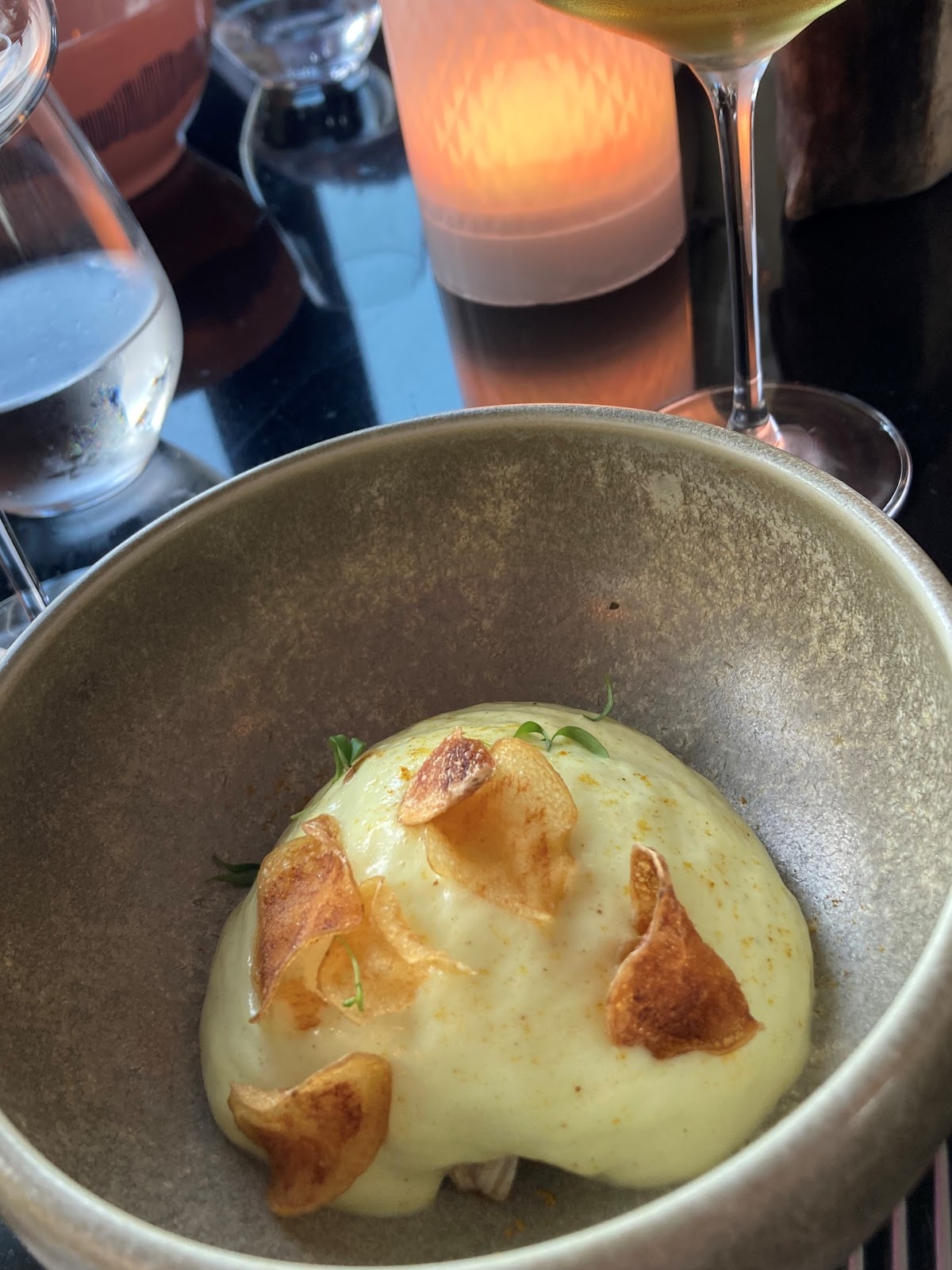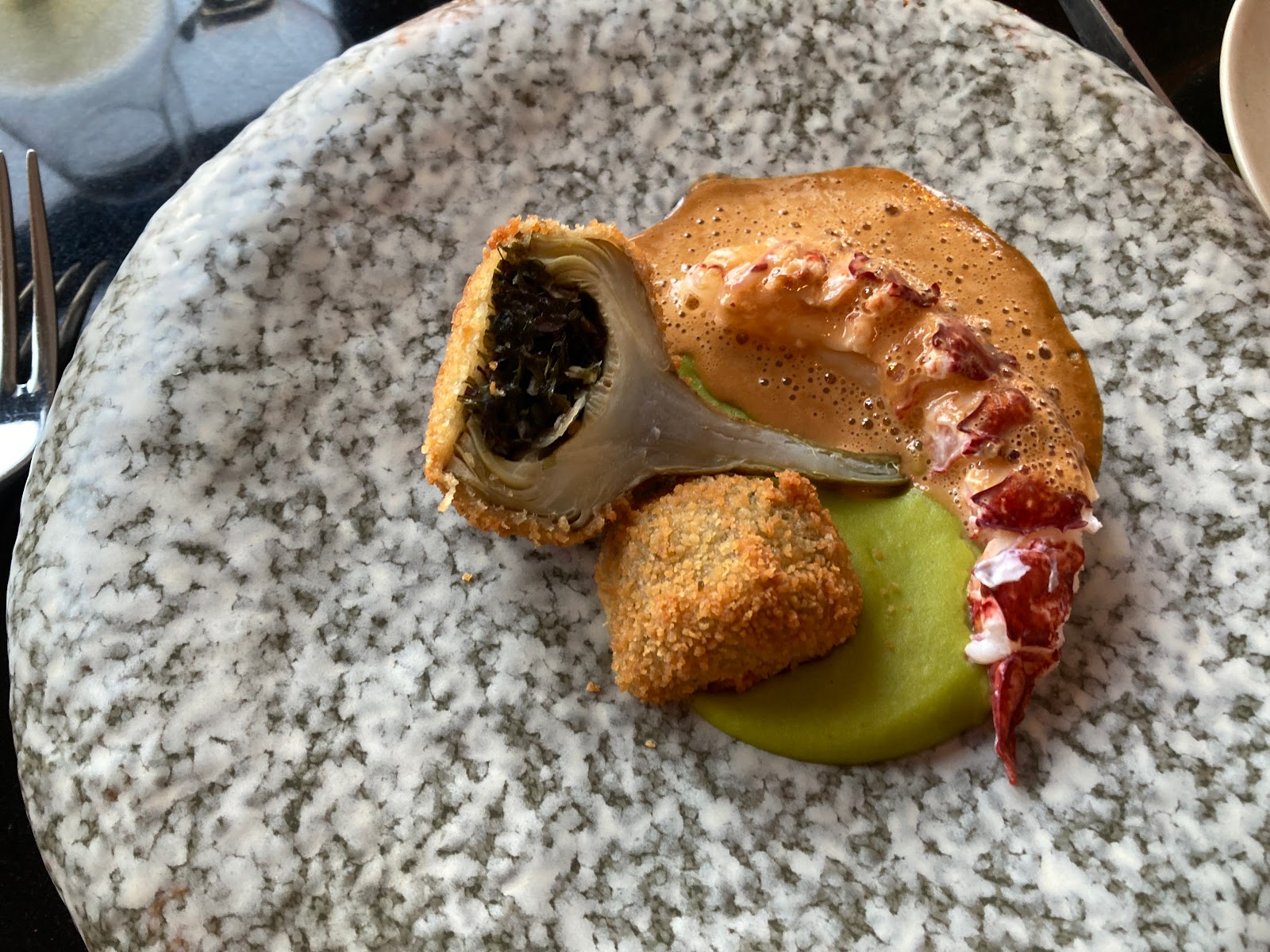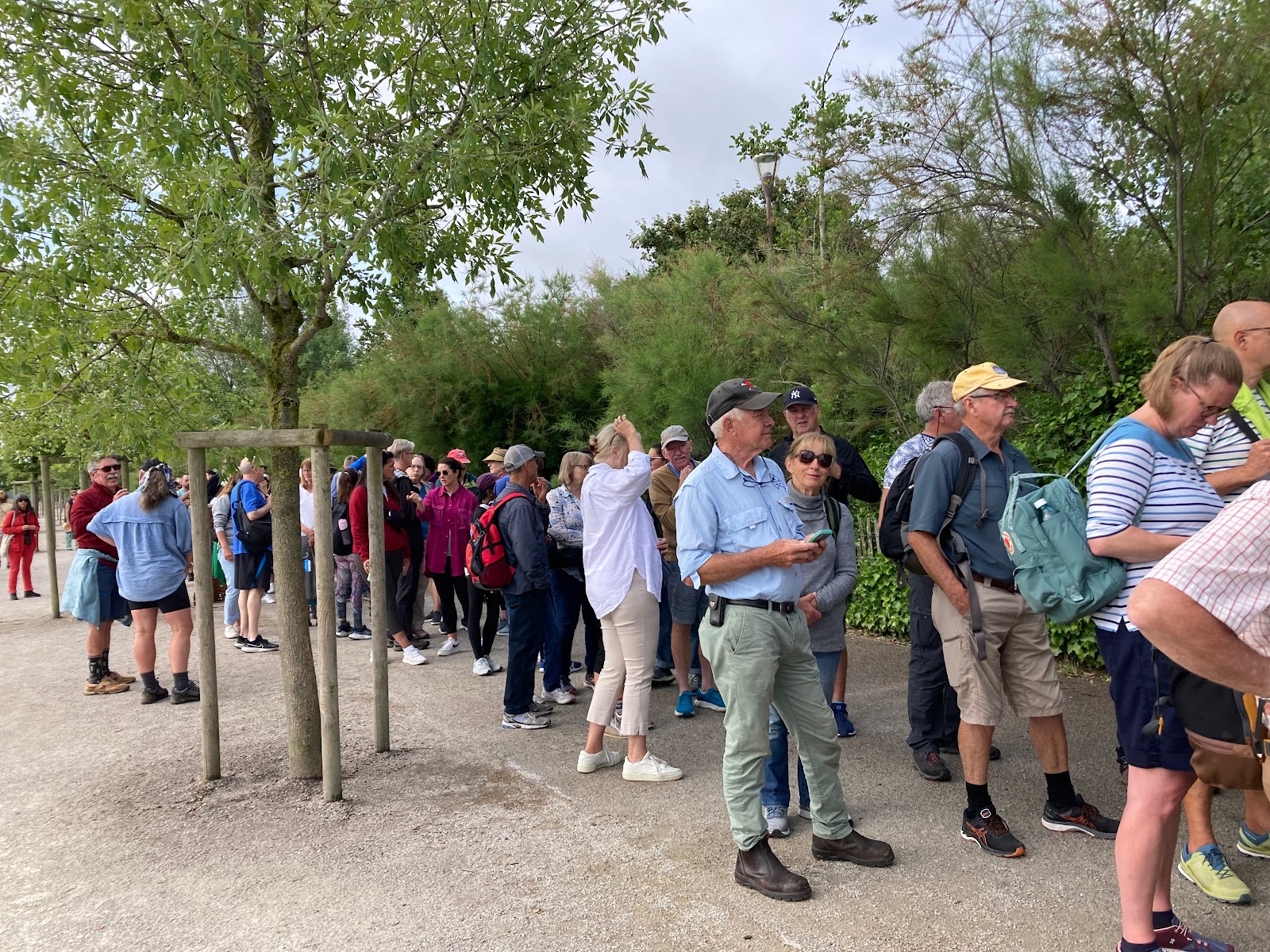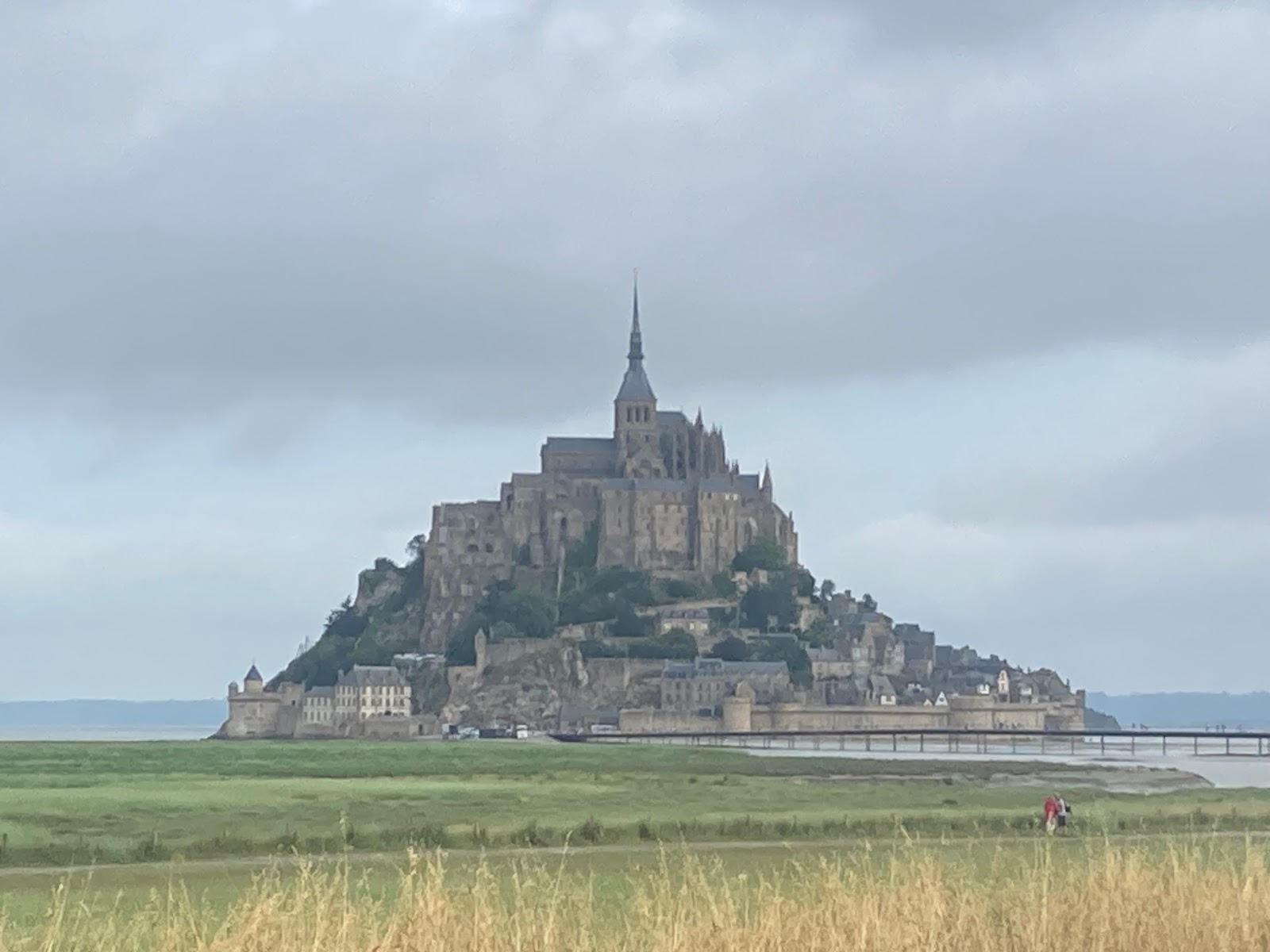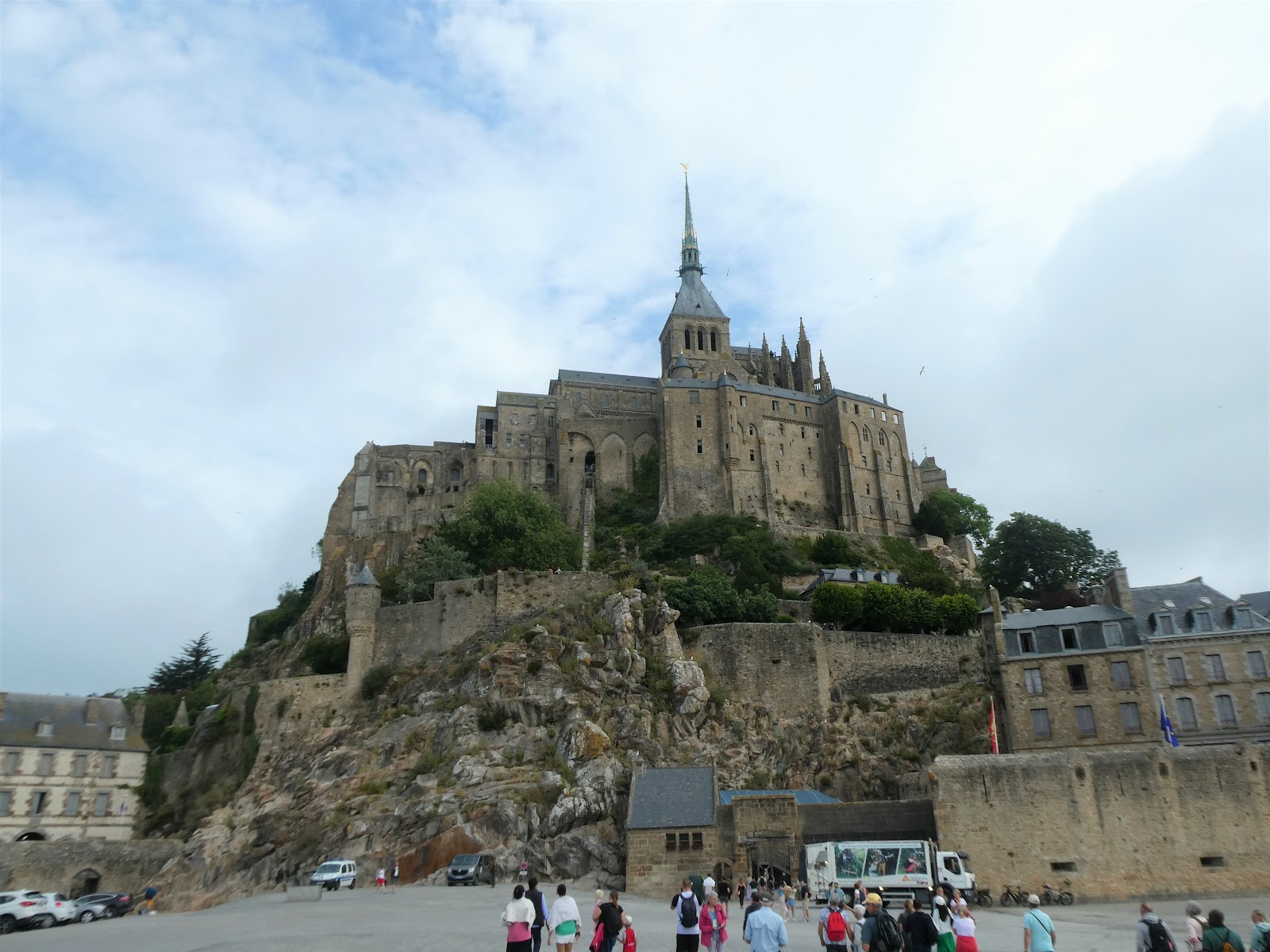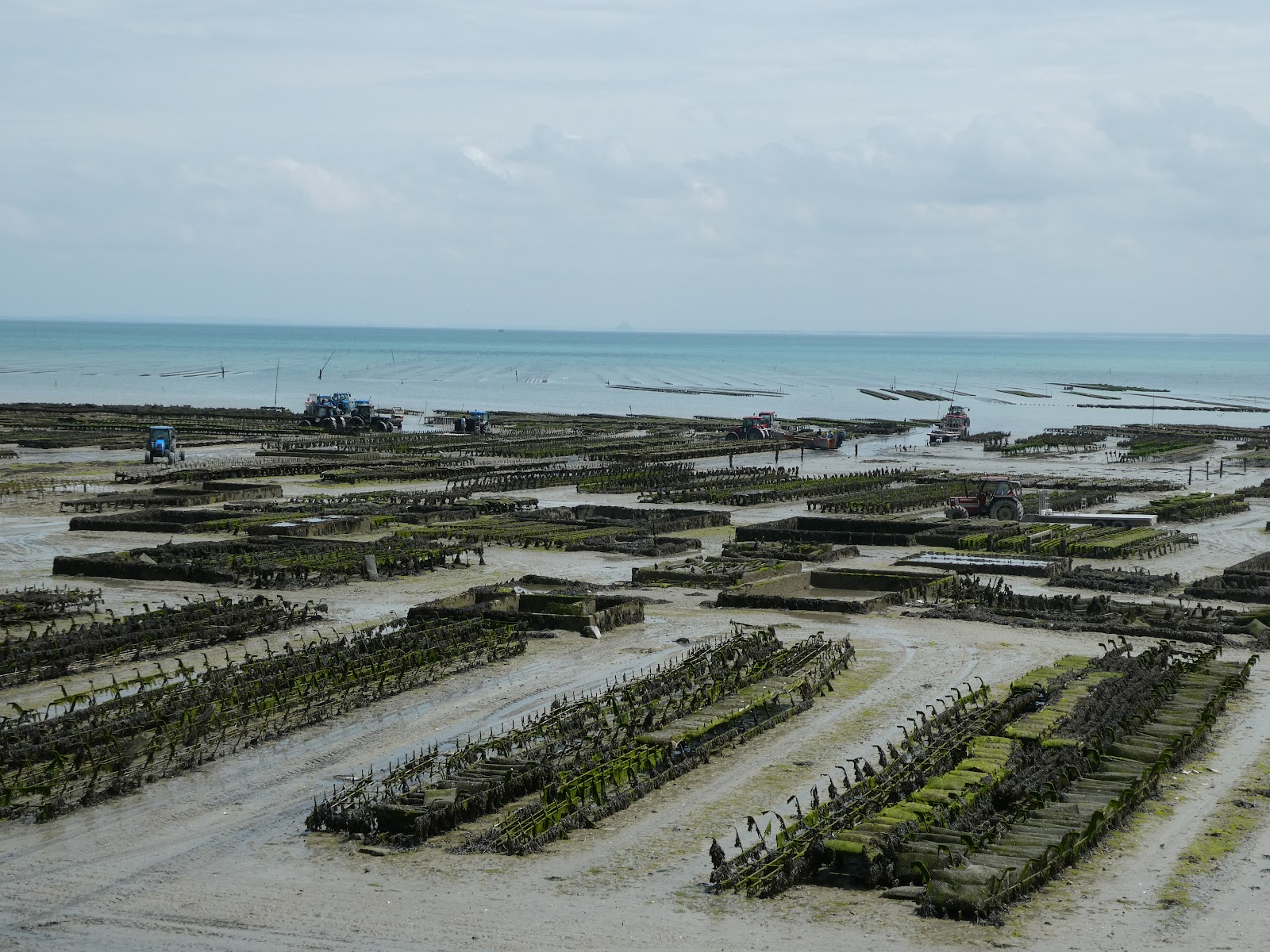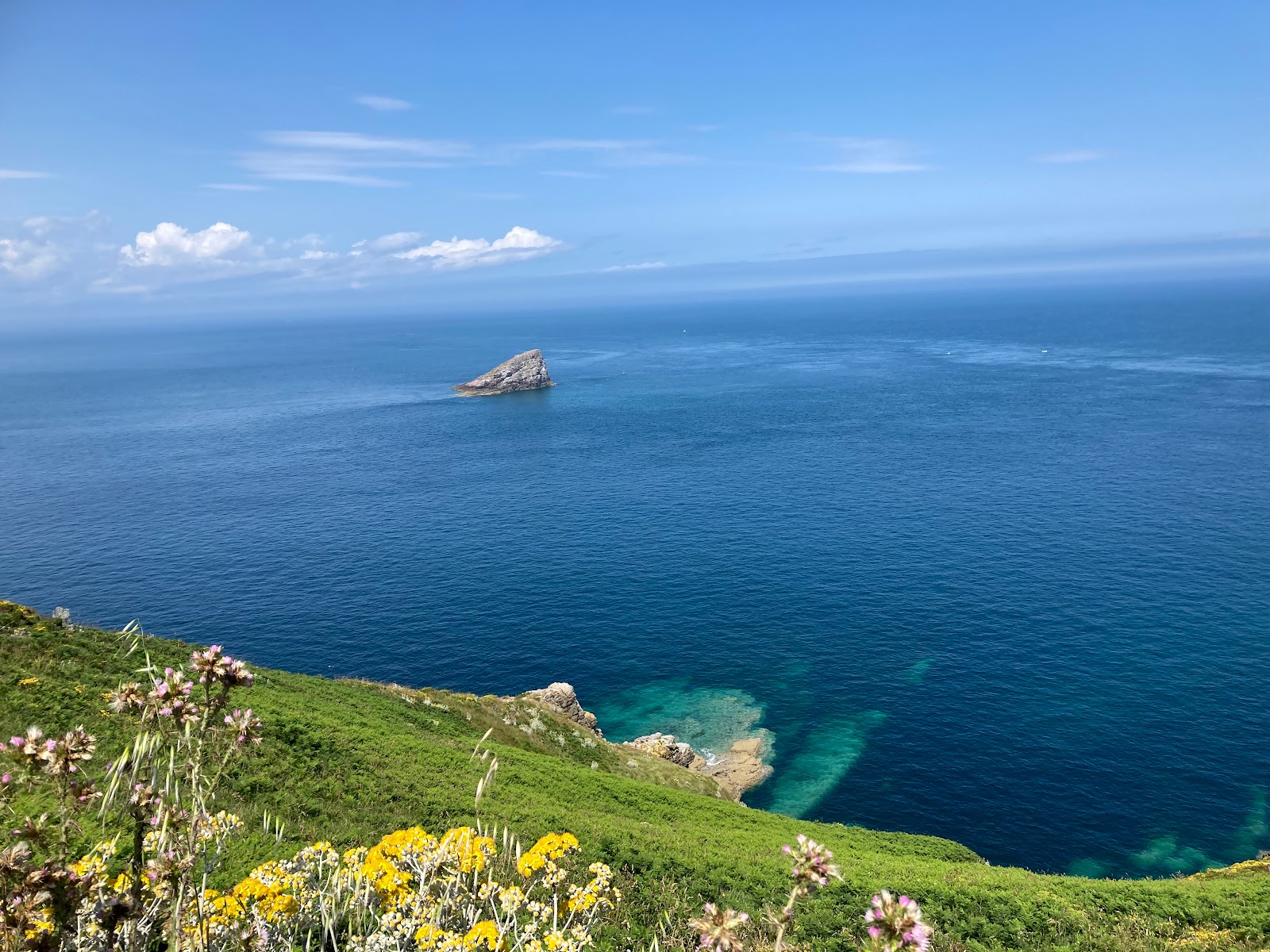After a relaxing week on the canal boat, travel on a packed train to Rennes to pick up our rental car was a harsh return to the real world. Many of our travelling companions were heading to Rennes for a Rainbow Pride protest or parade (probably both knowing the French). The day was very warm, and our car hire didn't start well when I managed to tear a tyre sidewall in my attempts to get from the rental carpark back to the Gare to pick up the the rest of the crew. Google Maps was trying to send me the wrong way up one way streets and even indicated I should drive up bollarded streets. Lots of roadworks underway meant many streets were lined by temporary fencing. I clipped one of the concrete fence stabilising blocks and managed to rip a tire sidewall. After setting up a replacement car and contract we set off for St Malo, the old walled city on the Brittany coast.
The road trip was easy enough until we arrived in the old walled city. It was chockful of pirates and people. Turns out we arrived on the official Pirate Day (Jour des Corsairs). A bit later in the day Vikki and Ann got distracted from a supermarket trip by the parade of pirates.
St Malo is associated with the pirates from ancient days. The town was home base for many of the privateers who roamed the oceans searching for merchant ships to relieve of their cargo and any bullion or gold from South America and Mexico. Most of the prospective targets were on voyages home to England or Spain, and the British Navy, controller of the high seas, also roamed the high seas looking to capture said pirates. They had their work cut out to suppress piracy if the reading of my youthful years was accurate on this topic.
The city has significant defensive walls and ramparts, but was made even more formidable by a forward line of four defensive forts, all in sight of the city out in the Bay. The city remained a thorn in the side of England whose navy failed to penetrate its defences, despite a few significant attempts.
Our accommodation host met us at the appartment to show us the ropes. It's a spacious apartment with three bedrooms but with no phone signal due most likely to the place being surrounded by very thick granite walls. The wifi was pretty slow too unfortunately.
Navigating the car in the city's narrow lanes is challenging and driving even more so. The garaging provided was in the middle of the town, underground below one of the city's places. It was a very tight squeeze, but it's good to have secure parking.
We wandered around town looking for a place to dine later in the evening and found a suitable spot adjacent to our parking place. The restaurant had a small gathering of pirates carousing at one of the outside tables, so we dined inside. We had a chat with the pirate group after our meal. None were full time in piracy mode, one of our conversationalists was an HR recruitment person in his daytime job.
Pretty grey morning next day, Choco commented there was a 30% chance of rain, but we headed off to do the 1.6 km walk around the ramparts. This gave us views into the old city and out to the newer parts of town and the channel. We had a highish tide, the range here is between about 4 m for neap tides and 9.5 m for spring tides, so there is a lot of water movement. Our sea views were pretty grey and misty, but you get that with maritime climates. The 30% chance of rain got to 100% as we were about a third of the way around the walk.
Later in the day we got low tide pictures of high and dry forts, with lots of visitors walking out to view them.
We joined the throng and explored Fort National, the most prominent of the offshore fortifications which was easily accessed across the sand at low tide. It served variously as defence garrison, a prison, and in World War II a hostage camp when the Germans held all the French men to prevent any rebellion in Saint Malo.
In the American assault 19 local died and 80% of the city was destroyed. This was now painstakingly restored. Anthony Doer's novel All the Light You Cannot See details much of this history. (They say that its brought a huge increase in tourism to Saint Malo; a mixed blessing for a very enclosed town!) Views of Saint Malo are impressive from the fort.
Further round the walk are a couple of lovely sandy beaches. The main one at high tide appeared to have a diving platform sticking out of the water about 100 m off the beach. When we returned for low tide pictures, there was a large swimming pool evident, quite a cool concept.
Our rampart walk extended to one of the shipping basins and then back along the foreshore road which is about 10 m above the sand. The granite wall also has a forest of tree trunks driven into the sand to make some additioal protection from the waves.
Many of the tourist gift shops had photos on display of waves crashing over the sea walls and into the streets and we did see warning signs on our beachside stroll.
There are several large shipping basins accessed by a lock to keep shipping safe and isolated from the 9 m of tide movement. The tides are also utilized for power generation and the Barrage de la Rance, was built in 1966 for this purpose.
But outside of the basins many of the local boats just lie on their sides waiting for the sea to come back.
St Malo has several ferry routes across the channel and to the Jersey islands. Choco and Vikki will leave on one of those in their pilgrimage to Lords (the cricket ground) to watch part of the Ashes test there.
In the 17th century control on movement in and out of the walled town was very strict. The gate was closed at 10 pm and those breaking the curfew had to sleep in the gatekeeper's room until morning. Large English mastiffs roamed the streets to ensure compliance!
Sunday night dinner was our Michelin star dining event for this trip with Choco and Vikki. We have established this as standard practice each Europe trip. Our restaurant was Pourquois Pas, across the harbour by ferry at Dinard. We arrived early enough to do a walk around the foreshore with views of some beautiful mansions on the headlands.
One of these more isolated houses is reputed to be the Norman Bates house of Psycho fame.
A statue of Hitchcock on the foreshore recognises his role in the Dinard annual film festival.
Unfortunately the 30% chance or rain once again became 100%. Fortunately not heavy rain, but it did send us early to the hotel where the restaurant is based.
Fortunately again they had a bar where we could wait out our appointed time. Staff were terrific, and we had a leisurely opportunity to discuss whether we would do the 4, 6, or 8 course degustation menu, and whether we would take the matching wine option. Some debate on the former, none on the latter. We took the 6 course option, because these dinners always start with some amuse bouches which add a few more tasty morsels to the evening.
This was a memorable dinner, beautifully presented food and lovely wines. I'm sure the pictures will adequately tell the story. Periwinkles, oysters, poisson cru, spider crab, langoustine .....
The food, almost all seafood, was sensational, and the staff were very very good, even to the extent we were escorted from the premises to make sure our taxi home was there!! Stunning views over to Saint Malo as we dined.
The bill, for the record, was 700 Euro; luckily for us it's the first time in five years we've had the opportunity to do this, and we are happy to have had the opportunity again.
Monday morning we extracted the car from its tight-fitting garage and set off for Mont Saint Michel along with many thousands of other tourists. The car parking is a few km from the islet, but they provide a bus service to the base of the structure. It is a very imposing, grand sight as you approach.
We had prepurchased tickets so were able to climb the streets and steps to the abbey to do our self guided tour. The first area travelled through three gates to a street called La Grande Rue, filled with tourist shops, and then came the steps, lots of them!
The abbey was build after Archangel Michael visited the local bishop twice in his dreams to suggest this place should be built to honour God. The bishop thought about the message but didn't do anything because he was worried it may have been the Devil appearing in his dreams. Archangel Michael came once again and this time pressed his thumb into the bishop's forehead, leaving him in no doubt he should get on with the job.
It's a small island, with a peak not big enough to build a grand church, so much of the church and its servicing buildings are built over the top of four huge crypts which support the huge weight above. We toured the abbey, refectory, grand guest hall with giant fireplaces, the cloisters and supporting crypts. (Note the beheaded saints, a product of the Revolution!)
Up to 50 monks lived here at a time, and a village grew up on the lower slope to support the monks and the Abbey. It's an impressive granite structure, and you do marvel a bit as you do the tour. How did they do that in those time without the tools we now have to do such work? In the early stages of construction stonemasons were paid by the number of stones they cut, so marked their stones for the tally.
At the end of the interior visit there's the opportunity to see the clear stages in its construction, appropriately called La Merveille. You can see half finished elements among the structure where money ran out or events interceded.
In the 18th century the Mont was used as a prison and six prisoners at a time powered a giant treadmill to lift stone and other supplies up the hill.
The tides around the Mont are some of the largest in Europe with a 15 m range. There is a huge expanse of sand and mudflats exposed as the tide recedes.
We departed the Mont and took the coastal route to Cancale, the oyster capital of Brittany, past evidence of oyster farming in the bay, and houses build along the shore in old windmill buildings. Most now have no traces of the wind sails, but a few survive intact.
It would seem that Brittany produces many vegetables for France and we passed fields of peas, shallots and lettuces in particular, along with green and golden wheat and maize.
Cancale is spectacular too; large areas of oyster racking are exposed at low tide, and the farmers are out there in the sand and mud with some very large dinghy style boats, towed by significant wheeled tractors with VERY wide tires. Obviously a tough environment for gear, and much rust was evident.
We tasted two types of the four oyster types available. Our oyster selling lady gave us the shucked oysters on a tray, with forks and a lemon, and the instructions on how to proceed. Forks and tray you return to me, shells throw on the beach and the lemon into a special lemon bin! All in French, but we got the picture. We did that twice then bought three dozen (20 Euro) to take home for dinner.
For our final day with Choco and Vikki we headed west in the car to the views of Cap Frehel lighthouse. The water far below the cliffs is crystal clear and emerald in colour, giving this coast its common name, The Emerald Coast. From this viewpoint we could see at least three other fortifications. It's a heavily protected coastline. The wildflowers, heather and dwarf gorse provided a great splash of colour.
This whole coastline is heavily fortified. From Cap Frehel we could see three other forts. Next port of call was Fort Latte, built to keep the Normans at Bay in the 12 century. We've seen a few castles so didn't do the tour today.
After farewelling Wayne and Vikki and dropping them off to their cross channel ferry, we had a dine-in night and spent time catching up with FB and Blog posts, with nothing being done for the last two weeks.
Final day for us was an earlyish departure to return the car to Rennes, and find our overnight accommodation. Our departure from Saint Malo was blocked by randomly parked car and trucks at our first two attempts, and once we got outside we found our road south was all flashing lights and "Route Barre". Thank goodness for compliant navigation systems. Not sorry to farewell our MG car. Its propensity to sound the alarm when locked, and shift to camera view when in confined quarters ( read one-way street, walled cities) has not endeared it to us!






